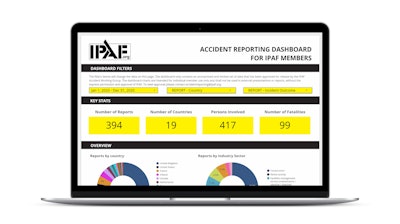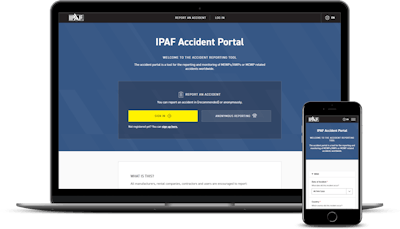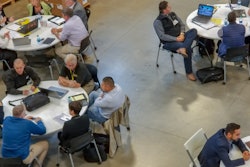
We learn from our mistakes. It’s as true for accidents working at height as for anything else. But IPAF is taking the process of learning from past failures to new heights with the recent launch of its new accident reporting portal (www.ipafaccidentreporting.org).
Brian Parker, head of safety and technical for IPAF, explains that while the old accident reporting portal was helpful, the new one, launched in September 2020, makes significant improvements to the way in which data is collected.
“Previously, rental companies and operators could enter free text, and if that wasn’t aligned to something in one of the categories that the portal expected, then it would sit in ‘other.’ That meant you couldn’t draw such good conclusions,” he says.
The portal has been completely reorganized so that users are now prompted to choose from specific categories, which can help reveal the precise nature of an incident and who was involved. Users are asked a series of questions about the circumstances surrounding the incident: when and where it happened, who was using the machine, what the ground conditions were, the nature of any injuries or fatalities and who was hurt, whether users were trained or experienced, the type of machine involved, what sector the accident happened in, and even what the weather was like.

“Where the portal comes alive is filtering,” says Parker. “It tells us where incidents are happening and gives insight into how they are happening.”
So far, the portal is collecting data around 20 countries worldwide, mostly from IPAF members and representatives in certain countries, though users don’t have to be IPAF members – they can log in anonymously should they happen to be a concerned member of the public, for example.
The portal is also available in the nine core IPAF languages (English, Chinese, Dutch, French, German, Italian, Korean, Portuguese, and Spanish). Currently, reporting through the portal is mandated in the UK as a condition of achieving IPAF Rental+ standard to be a rental member, and Parker hopes that similar initiatives will be introduced to other countries.
Using Better Data to Inform Training
Paul Roddis, IPAF training manager, is enthusiastic about how the new portal is informing IPAF’s efforts to focus training where it is needed and improve the safety of the industry.
Information from the new portal has already revealed that most accidents during the delivery of MEWPs occur during loading or unloading, which led to an overhaul of the organization’s existing Load/Unload course, for example.
“We could see from our analysis that most accidents involved the delivery driver. We were also able to look at when incidents were happening, and it was most commonly during the loading or unloading and while ‘walking’ a MEWP. We have been teaching operators to walk a MEWP for a long time, but it wasn’t in the Load/Unload course,” says Roddis.
"We might not like what we see, but if we don’t learn from the incidents we have, how are we going to make things better for the future?" – Brian Parker, IPAF
“We looked at the statistics and every incident we came across for walking a MEWP involved people loading and unloading, often in their own depot or yard. We should have been focusing on those people and now we have been able to change that. Being able to create an updated Load/Unload training course tailor-made to that type of person means it has become far more effective.”
Now Roddis is focusing his attention on promoting a new training course targeting site assessments, specifically relating to MEWP selection. “We have the MEWPs for Managers and MEWP Supervisor training course, which does talk about MEWP selection. But looking at the statistics, which show that falls from height are the greatest cause of fatalities year in, year out prompts the question: How do you fall from a MEWP?
“When you think about it, if it is being used correctly, you can’t. The answer has to be that people are climbing up because the machine doesn’t reach high enough because it is the wrong machine or in the wrong configuration. Similarly, some machine overturns are a result of heavy machines on ground that can’t support it. It’s a case of using the data to see what is happening and then extrapolating that. We can now look at the whole range of things that are happening. That doesn’t so much provide answers, but it is at least leading us to ask the right questions.”
“This is how we learn from accidents,” adds IPAF’s Parker. “We might not like what we see, but if we don’t learn from the incidents we have, how are we going to make things better for the future?”
He is eager to ensure that as many IPAF members as possible report incidents to the portal, highlighting the fact that even if it appears from increased reporting that more incidents are taking place in the short term, in the longer term, it will lead to better analysis and ultimately to safer work at height.




















